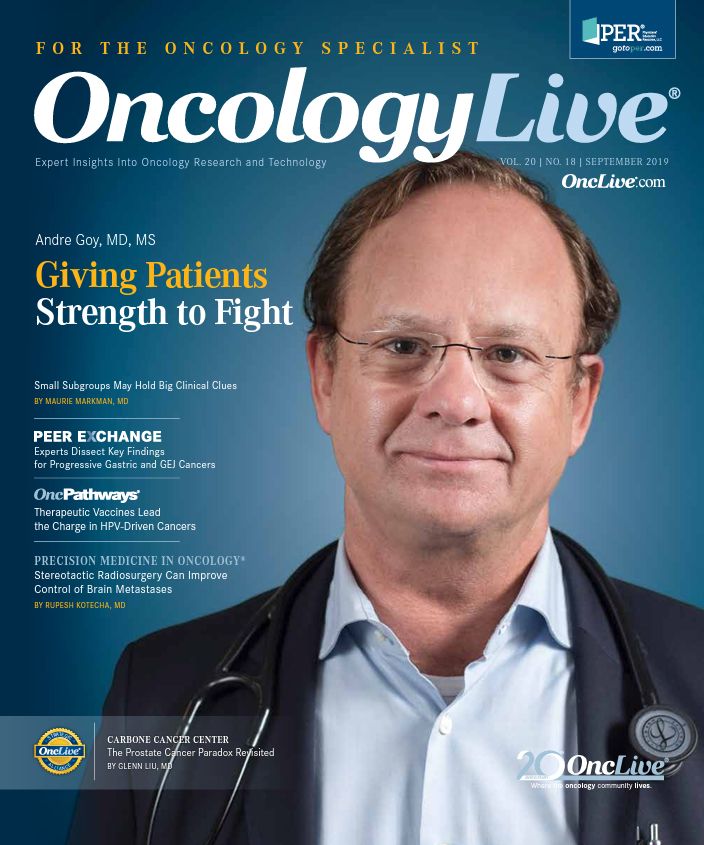Publication
Article
Oncology Live®
Workplace Accommodations Would Ease the Burden for Patients With Cancer
Author(s):
Women with breast cancer who have lower incomes and are members of minority populations are less likely to return to work following surgery and chemotherapy, and oncologists need to help them obtain workplace accommodations to ease their return to employment.
Victoria Blinder, MD, MSc, of the Immigrant Health and Cancer Disparities Service at Memorial Sloan Kettering Cancer Center

Victoria Blinder, MD, MSc
Women with breast cancer who have lower incomes and are members of minority populations are less likely to return to work following surgery and chemotherapy, and oncologists need to help them obtain workplace accommodations to ease their return to employment, said medical oncologist Victoria Blinder, MD, MSc, of the Immigrant Health and Cancer Disparities Service at Memorial Sloan Kettering Cancer Center.
Workplace accommodations are necessary because financial toxicity during treatment may impair a patient’s ability to successfully fight cancer and retain employment over the long term, Blinder said in a recent presentation at the 2019 American Society of Hematology Oncology Annual Meeting (Figure1-3).
“If you heard that there was an epidemiologic risk factor that almost doubled your risk of dying from cancer, everyone would run screaming. But nobody is running and screaming while talking about financial toxicity,” Blinder said.
Women with breast cancer who are nonwhite, come from low-income households, and work in the underground economy are less likely to have access to work accommodations such as sick leave and disability benefits during their treatment, or even time off for a medical appointment, translating to an increased risk of job loss. A lack of work accommodations can hinder patients’ subsequent reentry to the workforce following time off for treatment, Blinder said.
Approximately 80% of women who receive a diagnosis of early-stage breast cancer have returned to work 1 year later, but at the 3-year point, just 53% and 59% of low-income Latina and non-Latina white women, respectively, are back in the workforce, Blinder said.4,5
In a study of women with a household income of less than $50,000, which is roughly twice the federal poverty level, “We saw that 6 months after curative surgery for breast cancer, less than half of the participants were working. And we saw that there was a disparity on the basis of ethnicity, with only 27% of Latinas working compared with 49% of non-Latina whites,” Blinder said.5
“Following the same sample out for a total of 5 years, we looked at cumulative workforce reentry, and we saw that at 6 months, only 36% of the women had reentered the workforce. And with each subsequent time point, there was a decreasing rate of reentry into the workforce. [It] plateaued off toward the end,” Blinder said.
Work status following a cancer diagnosis differed among racial and ethnic groups in another study, Blinder noted.6 Eligible to participate in the Breast Cancer in the Workforce study were working women aged between 18 and 64 years with stage I to III breast cancer who were undergoing chemotherapy or radiation therapy or who had completed their surgery <60 days before the study’s initiation. At baseline, investigators surveyed 702 immigrant and minority women across New York City who spoke either Chinese, English, Korean, or Spanish; 488 women were included in the follow-up.
Blinder, the principal investigator, said 71% of participants were working either full-time or part-time 4 months after treatment completion. However, employment status differed between groups: 72% of black women, 65% of Chinese women, 68% of Korean women, 62% of Latina women, and 90% of non-Latina white women continued to work during this period.
Investigators included a control arm of 420 working women who did not have cancer, matched for race, ethnicity, and immigrant status. At the time of posttreatment follow-up, 90% of the control-arm patients were working. The ratio of working patients versus controls at this 4-month posttreatment follow-up point was 0.78 for black women, 0.69 for Chinese women, 0.73 for Korean women, 0.75 for Latina women, and 0.98 for non-Latina white women.
The ratios were statistically significant for the black, Chinese, and Latina groups. Blinder said that the study under-accrued the arm of Korean women, hypothesizing that this arm’s ratio would also have been statistically significant had the arm been fully accrued.
Findings indicate that improving access to accommodations may prevent job loss, Blinder said. About half (46%) of new cancer cases are diagnosed in people of traditional working age, defined as 20 to 65 years, suggesting a broad need for such accommodations among those who receive cancer diagnoses.
Figure. Job Loss Exacerbates Financial Toxicity and Risk of Death
Further, the rising costs of pharmaceuticals and healthcare services may force patients to spend more of their discretionary income on health maintenance. The average patient with cancer pays $4800 a year out of pocket.7
References
- Blinder VS. Mitigating financial toxicity by supporting employment. Presented at: 2019 American Society of Clinical Oncology Annual Meeting; May 30, 2019; Chicago IL. meetinglibrary.asco.org/record/170713/slide.
- Banegas MP, Guy GP Jr, de Moor JS, et al. For working-age cancer survivors, medical debt and bankruptcy create financial hardships. Health Aff (Millwood). 2016;35(1):54-61. doi: 10.1377/hlthaff.2015.0830.
- Ramsey SD, Bansal A, Fedorenko CR, et al. Financial insolvency as a risk factor for early mortality among patients with cancer. J Clin Oncol. 2016;34(9):980-986. doi: 10.1200/JCO.2015.64.6620.
- Bouknight RR, Bradley CJ, Luo Z. Correlates of return to work for breast cancer survivors. J Clin Oncol. 2004;24(3):345-353. doi: 10.1200/JCO.2004.00.4929.
- Blinder VS, Patil S, Thind A, et al. Return to work in low-income Latina and non-Latina white breast cancer survivors: a 3-year longitudinal study. Cancer. 2012;118(6):1664-1674. doi: 10.1002/cncr.26478.
- Blinder V, Eberle C, Patil S, et al. Women with breast cancer who work for accommodating employers more likely to retain jobs after treatment. Health Aff (Millwood). 2017;36(2):274-281. doi: 10.1377/hlthaff.2016.1196.
- Schipper LE. Elephant in the room: financial toxicity in cancer care. Presented at: 2019 American Society of Clinical Oncology Annual Meeting; May 31-June 4, 2019; Chicago, IL. meetinglibrary.asco.org/record/170338/slide.










